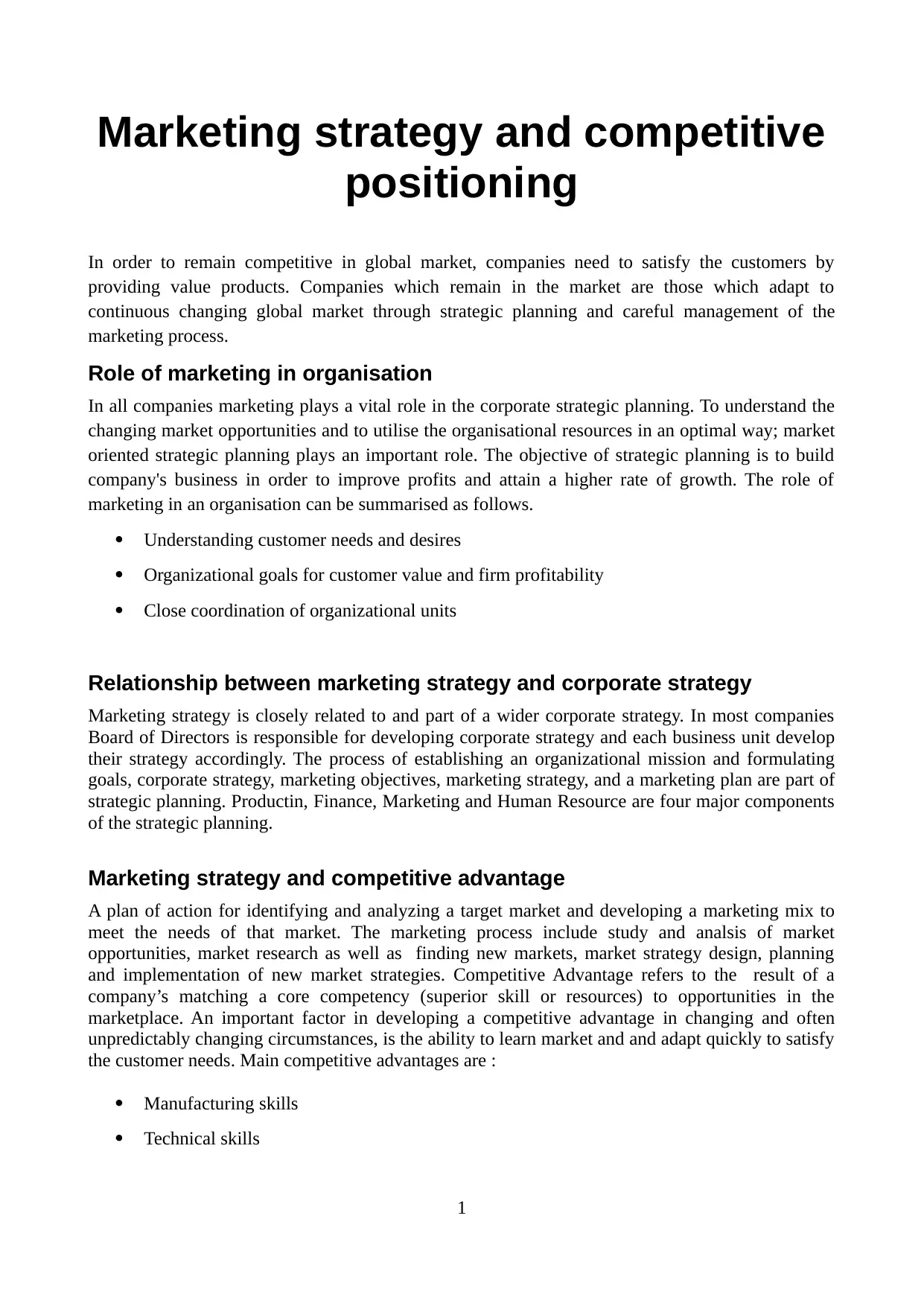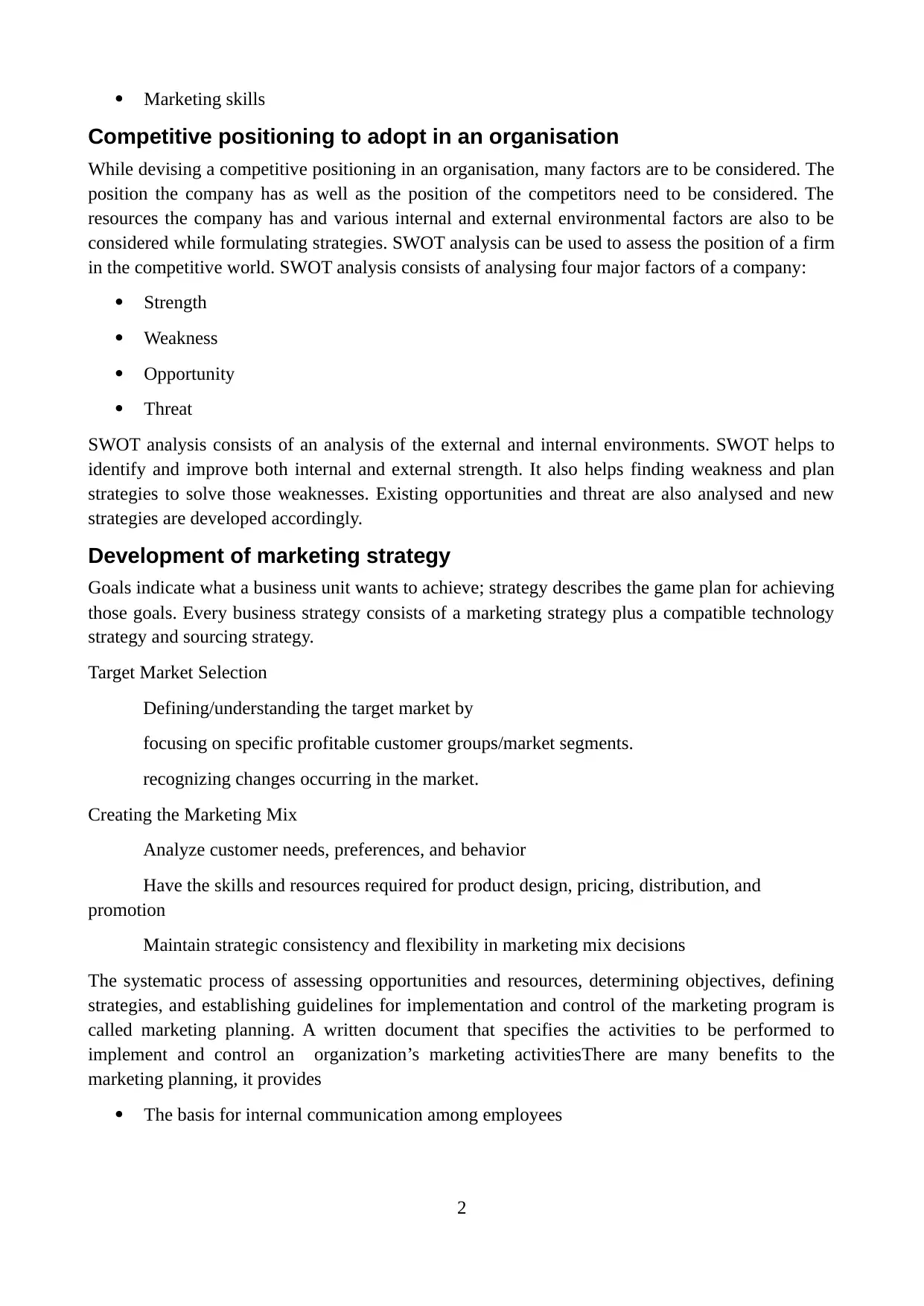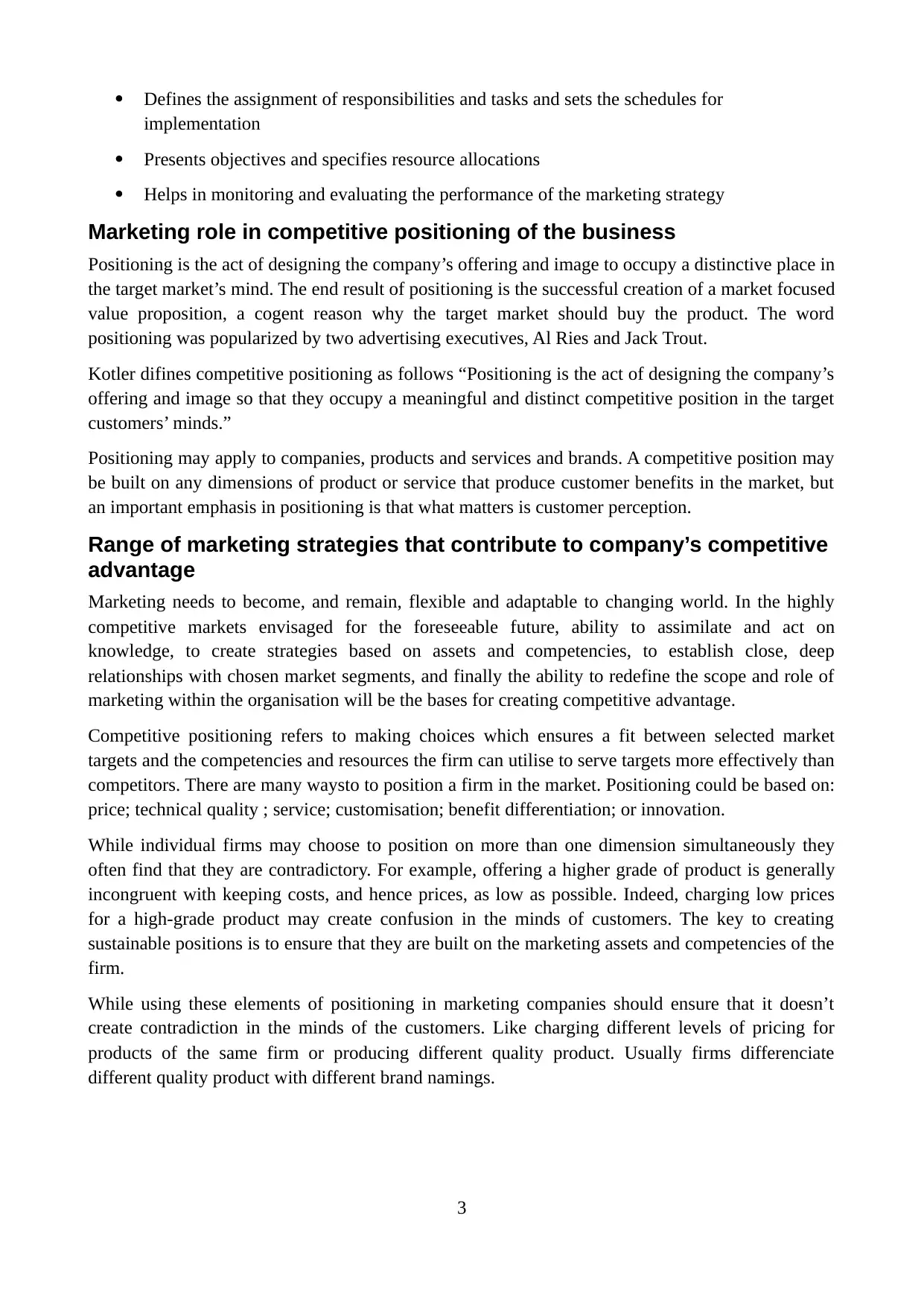Marketing Strategy and Competitive Positioning Report - Semester 1
VerifiedAdded on 2022/01/13
|3
|1175
|299
Report
AI Summary
This report explores the crucial role of marketing in organizational strategic planning, emphasizing the need for companies to adapt to the ever-changing global market. It delves into the relationship between marketing strategy and corporate strategy, highlighting the importance of understanding customer needs and desires, organizational goals, and the coordination of organizational units. The report examines competitive advantage, the marketing process, and competitive positioning strategies, including SWOT analysis, target market selection, and the creation of a marketing mix. It also discusses the importance of marketing planning and the range of marketing strategies that contribute to a company's competitive advantage, emphasizing the need for flexibility, adaptability, and strong customer relationships. The report concludes by discussing the importance of positioning a firm in the market and the various ways to achieve it.

Marketing strategy and competitive
positioning
In order to remain competitive in global market, companies need to satisfy the customers by
providing value products. Companies which remain in the market are those which adapt to
continuous changing global market through strategic planning and careful management of the
marketing process.
Role of marketing in organisation
In all companies marketing plays a vital role in the corporate strategic planning. To understand the
changing market opportunities and to utilise the organisational resources in an optimal way; market
oriented strategic planning plays an important role. The objective of strategic planning is to build
company's business in order to improve profits and attain a higher rate of growth. The role of
marketing in an organisation can be summarised as follows.
Understanding customer needs and desires
Organizational goals for customer value and firm profitability
Close coordination of organizational units
Relationship between marketing strategy and corporate strategy
Marketing strategy is closely related to and part of a wider corporate strategy. In most companies
Board of Directors is responsible for developing corporate strategy and each business unit develop
their strategy accordingly. The process of establishing an organizational mission and formulating
goals, corporate strategy, marketing objectives, marketing strategy, and a marketing plan are part of
strategic planning. Productin, Finance, Marketing and Human Resource are four major components
of the strategic planning.
Marketing strategy and competitive advantage
A plan of action for identifying and analyzing a target market and developing a marketing mix to
meet the needs of that market. The marketing process include study and analsis of market
opportunities, market research as well as finding new markets, market strategy design, planning
and implementation of new market strategies. Competitive Advantage refers to the result of a
company’s matching a core competency (superior skill or resources) to opportunities in the
marketplace. An important factor in developing a competitive advantage in changing and often
unpredictably changing circumstances, is the ability to learn market and and adapt quickly to satisfy
the customer needs. Main competitive advantages are :
Manufacturing skills
Technical skills
1
positioning
In order to remain competitive in global market, companies need to satisfy the customers by
providing value products. Companies which remain in the market are those which adapt to
continuous changing global market through strategic planning and careful management of the
marketing process.
Role of marketing in organisation
In all companies marketing plays a vital role in the corporate strategic planning. To understand the
changing market opportunities and to utilise the organisational resources in an optimal way; market
oriented strategic planning plays an important role. The objective of strategic planning is to build
company's business in order to improve profits and attain a higher rate of growth. The role of
marketing in an organisation can be summarised as follows.
Understanding customer needs and desires
Organizational goals for customer value and firm profitability
Close coordination of organizational units
Relationship between marketing strategy and corporate strategy
Marketing strategy is closely related to and part of a wider corporate strategy. In most companies
Board of Directors is responsible for developing corporate strategy and each business unit develop
their strategy accordingly. The process of establishing an organizational mission and formulating
goals, corporate strategy, marketing objectives, marketing strategy, and a marketing plan are part of
strategic planning. Productin, Finance, Marketing and Human Resource are four major components
of the strategic planning.
Marketing strategy and competitive advantage
A plan of action for identifying and analyzing a target market and developing a marketing mix to
meet the needs of that market. The marketing process include study and analsis of market
opportunities, market research as well as finding new markets, market strategy design, planning
and implementation of new market strategies. Competitive Advantage refers to the result of a
company’s matching a core competency (superior skill or resources) to opportunities in the
marketplace. An important factor in developing a competitive advantage in changing and often
unpredictably changing circumstances, is the ability to learn market and and adapt quickly to satisfy
the customer needs. Main competitive advantages are :
Manufacturing skills
Technical skills
1
Paraphrase This Document
Need a fresh take? Get an instant paraphrase of this document with our AI Paraphraser

Marketing skills
Competitive positioning to adopt in an organisation
While devising a competitive positioning in an organisation, many factors are to be considered. The
position the company has as well as the position of the competitors need to be considered. The
resources the company has and various internal and external environmental factors are also to be
considered while formulating strategies. SWOT analysis can be used to assess the position of a firm
in the competitive world. SWOT analysis consists of analysing four major factors of a company:
Strength
Weakness
Opportunity
Threat
SWOT analysis consists of an analysis of the external and internal environments. SWOT helps to
identify and improve both internal and external strength. It also helps finding weakness and plan
strategies to solve those weaknesses. Existing opportunities and threat are also analysed and new
strategies are developed accordingly.
Development of marketing strategy
Goals indicate what a business unit wants to achieve; strategy describes the game plan for achieving
those goals. Every business strategy consists of a marketing strategy plus a compatible technology
strategy and sourcing strategy.
Target Market Selection
Defining/understanding the target market by
focusing on specific profitable customer groups/market segments.
recognizing changes occurring in the market.
Creating the Marketing Mix
Analyze customer needs, preferences, and behavior
Have the skills and resources required for product design, pricing, distribution, and
promotion
Maintain strategic consistency and flexibility in marketing mix decisions
The systematic process of assessing opportunities and resources, determining objectives, defining
strategies, and establishing guidelines for implementation and control of the marketing program is
called marketing planning. A written document that specifies the activities to be performed to
implement and control an organization’s marketing activitiesThere are many benefits to the
marketing planning, it provides
The basis for internal communication among employees
2
Competitive positioning to adopt in an organisation
While devising a competitive positioning in an organisation, many factors are to be considered. The
position the company has as well as the position of the competitors need to be considered. The
resources the company has and various internal and external environmental factors are also to be
considered while formulating strategies. SWOT analysis can be used to assess the position of a firm
in the competitive world. SWOT analysis consists of analysing four major factors of a company:
Strength
Weakness
Opportunity
Threat
SWOT analysis consists of an analysis of the external and internal environments. SWOT helps to
identify and improve both internal and external strength. It also helps finding weakness and plan
strategies to solve those weaknesses. Existing opportunities and threat are also analysed and new
strategies are developed accordingly.
Development of marketing strategy
Goals indicate what a business unit wants to achieve; strategy describes the game plan for achieving
those goals. Every business strategy consists of a marketing strategy plus a compatible technology
strategy and sourcing strategy.
Target Market Selection
Defining/understanding the target market by
focusing on specific profitable customer groups/market segments.
recognizing changes occurring in the market.
Creating the Marketing Mix
Analyze customer needs, preferences, and behavior
Have the skills and resources required for product design, pricing, distribution, and
promotion
Maintain strategic consistency and flexibility in marketing mix decisions
The systematic process of assessing opportunities and resources, determining objectives, defining
strategies, and establishing guidelines for implementation and control of the marketing program is
called marketing planning. A written document that specifies the activities to be performed to
implement and control an organization’s marketing activitiesThere are many benefits to the
marketing planning, it provides
The basis for internal communication among employees
2

Defines the assignment of responsibilities and tasks and sets the schedules for
implementation
Presents objectives and specifies resource allocations
Helps in monitoring and evaluating the performance of the marketing strategy
Marketing role in competitive positioning of the business
Positioning is the act of designing the company’s offering and image to occupy a distinctive place in
the target market’s mind. The end result of positioning is the successful creation of a market focused
value proposition, a cogent reason why the target market should buy the product. The word
positioning was popularized by two advertising executives, Al Ries and Jack Trout.
Kotler difines competitive positioning as follows “Positioning is the act of designing the company’s
offering and image so that they occupy a meaningful and distinct competitive position in the target
customers’ minds.”
Positioning may apply to companies, products and services and brands. A competitive position may
be built on any dimensions of product or service that produce customer benefits in the market, but
an important emphasis in positioning is that what matters is customer perception.
Range of marketing strategies that contribute to company’s competitive
advantage
Marketing needs to become, and remain, flexible and adaptable to changing world. In the highly
competitive markets envisaged for the foreseeable future, ability to assimilate and act on
knowledge, to create strategies based on assets and competencies, to establish close, deep
relationships with chosen market segments, and finally the ability to redefine the scope and role of
marketing within the organisation will be the bases for creating competitive advantage.
Competitive positioning refers to making choices which ensures a fit between selected market
targets and the competencies and resources the firm can utilise to serve targets more effectively than
competitors. There are many waysto to position a firm in the market. Positioning could be based on:
price; technical quality ; service; customisation; benefit differentiation; or innovation.
While individual firms may choose to position on more than one dimension simultaneously they
often find that they are contradictory. For example, offering a higher grade of product is generally
incongruent with keeping costs, and hence prices, as low as possible. Indeed, charging low prices
for a high-grade product may create confusion in the minds of customers. The key to creating
sustainable positions is to ensure that they are built on the marketing assets and competencies of the
firm.
While using these elements of positioning in marketing companies should ensure that it doesn’t
create contradiction in the minds of the customers. Like charging different levels of pricing for
products of the same firm or producing different quality product. Usually firms differenciate
different quality product with different brand namings.
3
implementation
Presents objectives and specifies resource allocations
Helps in monitoring and evaluating the performance of the marketing strategy
Marketing role in competitive positioning of the business
Positioning is the act of designing the company’s offering and image to occupy a distinctive place in
the target market’s mind. The end result of positioning is the successful creation of a market focused
value proposition, a cogent reason why the target market should buy the product. The word
positioning was popularized by two advertising executives, Al Ries and Jack Trout.
Kotler difines competitive positioning as follows “Positioning is the act of designing the company’s
offering and image so that they occupy a meaningful and distinct competitive position in the target
customers’ minds.”
Positioning may apply to companies, products and services and brands. A competitive position may
be built on any dimensions of product or service that produce customer benefits in the market, but
an important emphasis in positioning is that what matters is customer perception.
Range of marketing strategies that contribute to company’s competitive
advantage
Marketing needs to become, and remain, flexible and adaptable to changing world. In the highly
competitive markets envisaged for the foreseeable future, ability to assimilate and act on
knowledge, to create strategies based on assets and competencies, to establish close, deep
relationships with chosen market segments, and finally the ability to redefine the scope and role of
marketing within the organisation will be the bases for creating competitive advantage.
Competitive positioning refers to making choices which ensures a fit between selected market
targets and the competencies and resources the firm can utilise to serve targets more effectively than
competitors. There are many waysto to position a firm in the market. Positioning could be based on:
price; technical quality ; service; customisation; benefit differentiation; or innovation.
While individual firms may choose to position on more than one dimension simultaneously they
often find that they are contradictory. For example, offering a higher grade of product is generally
incongruent with keeping costs, and hence prices, as low as possible. Indeed, charging low prices
for a high-grade product may create confusion in the minds of customers. The key to creating
sustainable positions is to ensure that they are built on the marketing assets and competencies of the
firm.
While using these elements of positioning in marketing companies should ensure that it doesn’t
create contradiction in the minds of the customers. Like charging different levels of pricing for
products of the same firm or producing different quality product. Usually firms differenciate
different quality product with different brand namings.
3
⊘ This is a preview!⊘
Do you want full access?
Subscribe today to unlock all pages.

Trusted by 1+ million students worldwide
1 out of 3
Related Documents
Your All-in-One AI-Powered Toolkit for Academic Success.
+13062052269
info@desklib.com
Available 24*7 on WhatsApp / Email
![[object Object]](/_next/static/media/star-bottom.7253800d.svg)
Unlock your academic potential
Copyright © 2020–2025 A2Z Services. All Rights Reserved. Developed and managed by ZUCOL.





